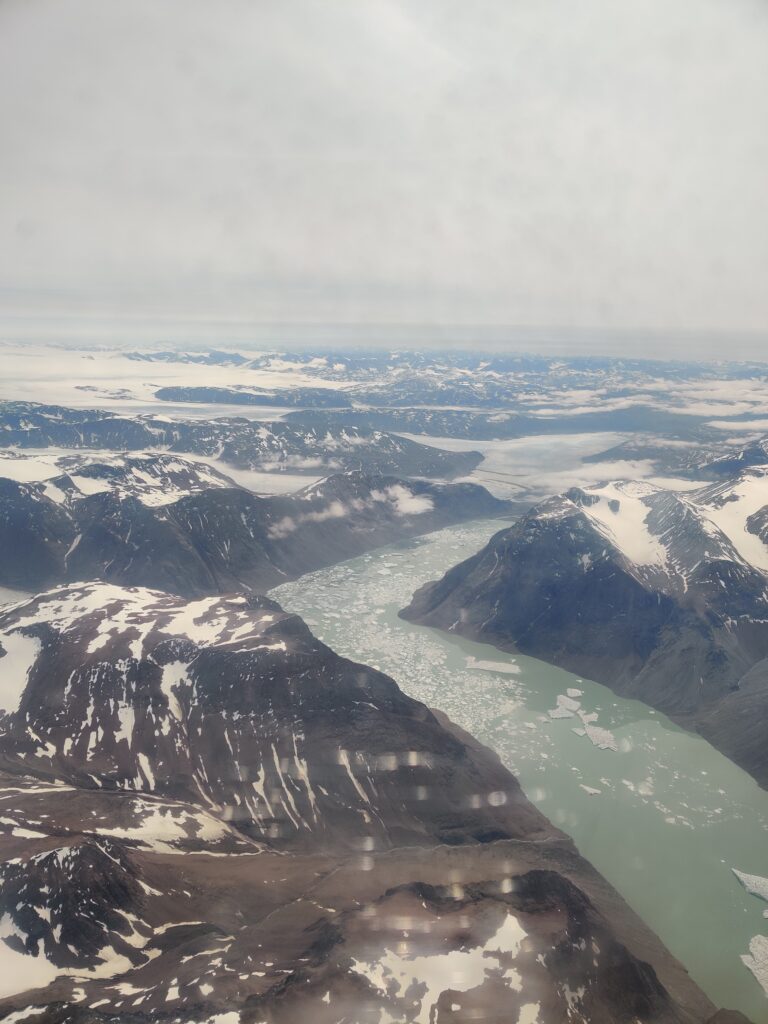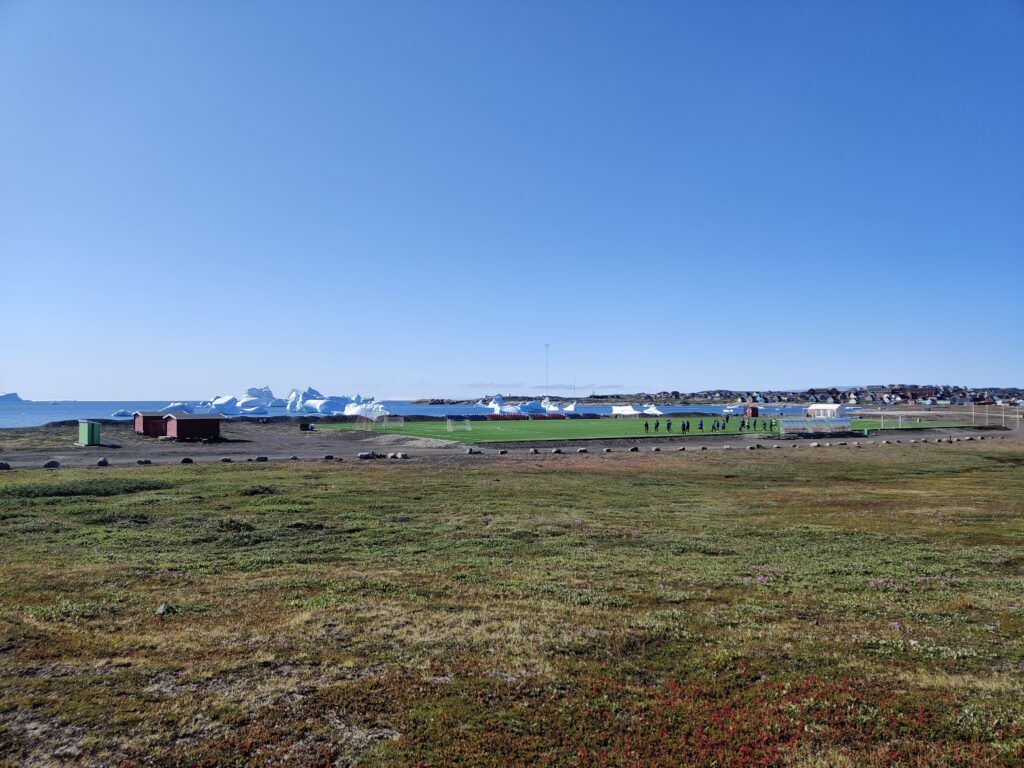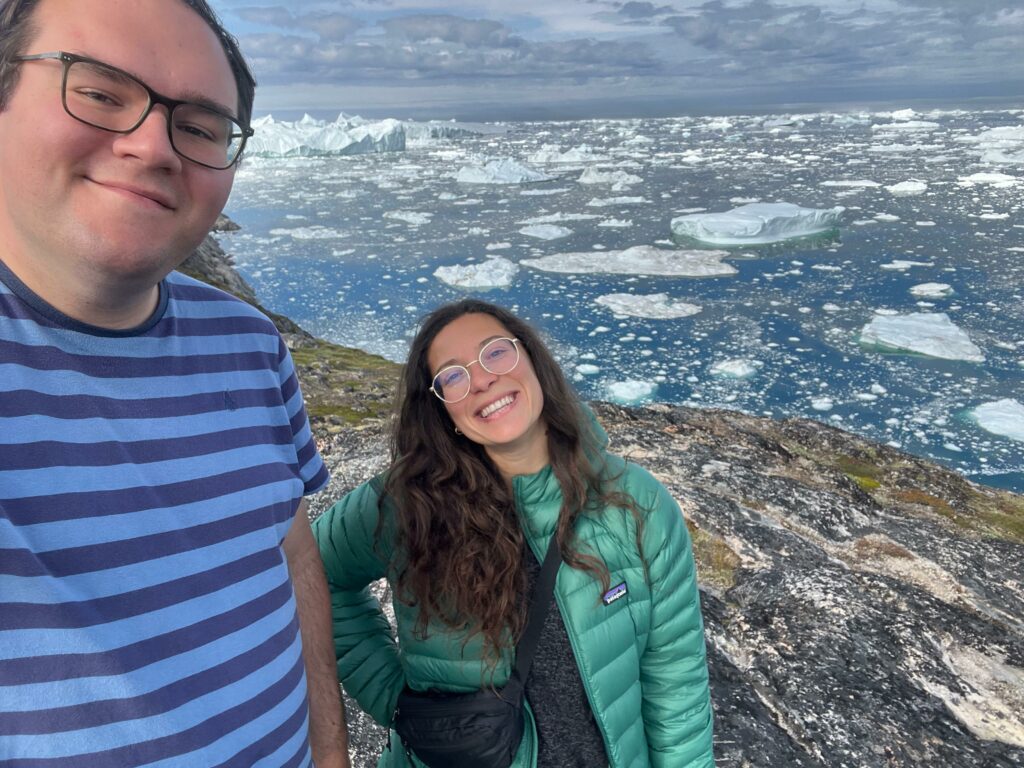Travelling across West Greenland is probably one the most unique experiences I had the chance to live. Sharing seven weeks of fieldwork in a couple of lines is not an easy task but let’s start with the beginning – the reunion with Brandon, my field mate and friend from the Natural History Museum in Copenhagen. We met in Copenhagen a couple of days before the Grand Départ to finish packing our field equipment and tick the last items off our packing list. From this moment, the excitement starts to grow. It is real. We are travelling across West Greenland for seven weeks to study plant-pollinator interactions in a warming world.
Landing in the fog
Only later did we fully understand, but we almost landed in Iceland instead of Greenland. Our first stop was Narsarsuaq, in Southwest Greenland, a settlement of just about 150 souls that used to be an American military airport during WWII. We also only realised after a couple of days one of Narsarsuaq’s defining traits – the fog. Approaching Narsarsuaq by plane, and Greenland in general I believe, is quite impressive – fjords give way to other fjords, glaciers, icebergs, mountains. As the plane was in the final descent, I remember saying to myself “There is no way we are landing here, there can’t be a runway”. A couple minutes after, we entered a thick fog. From this moment we heard from the cabin crew “Make sure that emergency exits are free” in a quite severe tone, two, three times. The pilot attempted to land a first time, a second time, then we heard “We are trying to land one more time, if we do not make it, we are going somewhere else”. Fortunately, third time’s the charm. From my window I suddenly saw the short runway and a couple of seconds later, we landed in Narsarsuaq. May our adventures begin!

Narsarsuaq was a pretty area. It was not the nicest, nor the most impressive place we visited, but it was surely the place where we met the nicest and helpful people. Andrea, who worked at the Blue Hostel where we stayed, was so enthusiastic about our research that she gave us loads of tips on where to sample and who to talk to. This led us to Ole, originally from Narsarsuaq, who manages a tiny museum. He is also the only beekeeper in Greenland. When we mentioned that we were biologists working on plants and pollinators, he immediately showed us the small insect collections kept away from sight in his museum’s storage room. He then said that we had to meet his partner Gitte, a plant enthusiast, she even wrote a book about the local flora (!!). They took us on hikes, showing us the hidden gem of Narsarsuaq landscape and flora, which highly contributed to make my first Greenland experience memorable.


Narsarsuaq surroundings. Narsarsuaq is one of the only place with trees in Greenland, however only two are native (Betula pubescens and Salix glauca), the others were introduced. © 2024 Nora Khelidj, all rights reserved
We also had a rather surprising “encounter” with the King and the Queen of Denmark on our (supposedly) last day there. They flew in Narsarsuaq to continue travelling by boat. The harbour being so small, it was very easy to greet them.
Narsarsuaq is also where we collected our first set of samples. The first step before starting to sample is to look at a map and set the possible interesting areas for plants and their pollinators. We heard of a place called Flower Valley a few kilometres from the hostel. We were very enthusiastic and positive, the area sounded promising. We left the hostel, going on our first hike to scout the area. After about an hour of walk we finally reached the valley, however it was not really what we expected. We could have easily renamed it Pasture valley. There were signs of evident pastoral activity, the area was mowed and grazed. Far different from what we expected from the few pictures we could find online. We were still highly motivated and confident that we would find appropriate areas for our sampling, and we did! We managed to complete our first sampling in a couple of days before leaving for our next destination.

A typical sampling day begins with setting up a plot in the first chosen habitat. We start by identifying each plant species within the plot. As a field biologist accustomed to the Alps, I was surprised by the number of species shared between Greenland and my home mountains—making identification much easier than expected. Once we have recorded the plant species, we turn our attention to pollinators. Catching them requires patience, especially when none are coming; you must stand still in the plot, keep watching carefully for an insect to land on a plant. The moment it does, you gently sweep your net, capture it, and place it in a small tube for further study. After 30 minutes spent on a plot you can move on to the next one and repeat the same procedure — unravelling the intricate networks between flora and pollinators in this Arctic landscape. To maximise our stay, we also collected samples for other research groups and projects studying Greenland diversity – a few flower seeds, mosses, and flowers for their herbarium.
Going north
From Narsarsuaq we went north up to Disko Island, with a couple of stops along the way to sample and obtain a latitudinal gradient of plant-pollinator interactions.
First in the region of Nuuk, the capital of Greenland, where we stayed at the Kobbefjord research station, a place off the grid. There is no connection there. We enjoyed a peaceful day, playing games and cooking freshly caught fish between two sampling sessions. Our following destination was Sisimiut, the second largest town in Greenland. From here we were above the Arctic circle where the sun does not set anymore, and we were welcomed with a rare gift: seven days of uninterrupted sunshine, perfect to sample a great amount of pollinators.


Left: The three small buildings of the Kobbefjord research station: Storage – Kitchen – Rooms. The station belongs to the Greenland Institute of Natural Resources. Right: Sisimiut surroundings. © 2024 Nora Khelidj, all rights reserved
We continued our journey further north, we reached Disko Bay, with a brief layover in Ilulissat. Its name, meaning “iceberg” in West Greenlandic, could not be more fitting. Towering ice giants drifted silently in the fjord, their presence both majestic and humbling. The sea around the town was a frozen gallery, filled with those massive sculptures of ice. From Ilulissat we embarked through this sea of ice to reach Qasigiannguit, our next sampling destination. For the first time since our arrival in Greenland, we were extremely unlucky with the weather. Sampling pollinators requires at least a partially sunny day, low wind and no rain. Unfortunately, our days in Qasigiannguit were filled with rain, wind and cold weather. For the first time we realised how sensitive it is to work with pollinators and living organisms in general. We had to learn that we cannot control everything and accept that we would have almost no sample from this location and prepare to move on to the next and last sampling destination– Disko Island.


Our final destination was Disko Island, the second largest island of Greenland. There we stayed at the Arctic station, about one kilometre from the main town. Many scientists from different fields and countries stayed at the station, creating a lively and inspiring environment. We met colleagues from the University of Copenhagen working in marine biology and organised a “cross-research day”, bringing them along with us for our daily sampling sessions. Beyond our scientific work, we also took part in cultural activities. In the evenings, after long days of sampling, we watched the Greenland Football Championship on the field just across from the station. Disko was not only hosting the championship but was also the favourite to win. The atmosphere was vibrant, filled with energy, excitement, and the shared joy of the game.


Leaving Disko Island meant leaving Greenland. We left the island with our mind full of pictures and memories and our suitcase filled with pollinators and flowers.
I want to warmly thank Brandon S. Whitley for the great company during the field campaign, the many laughs and jokes and memories I will cherish forever. I also thank Prof. Natasha De Vere at the Natural History Museum Denmark in Copenhagen for the amazing opportunity and collaboration on plant-pollinators network in Greenland, as well as Gianalberto Losapio, my PhD supervisor at my home University – University of Lausanne, for the support. Finally, I thank the Swiss Polar Institute that helped making this project come true through the Polar Access Fund.

Nora Khelidj is a PhD student at the Faculty of Geosciences and Environment at the University of Lausanne, Switzerland. Her field trip took place in summer 2024 with financial support of a Polar Access Fund.